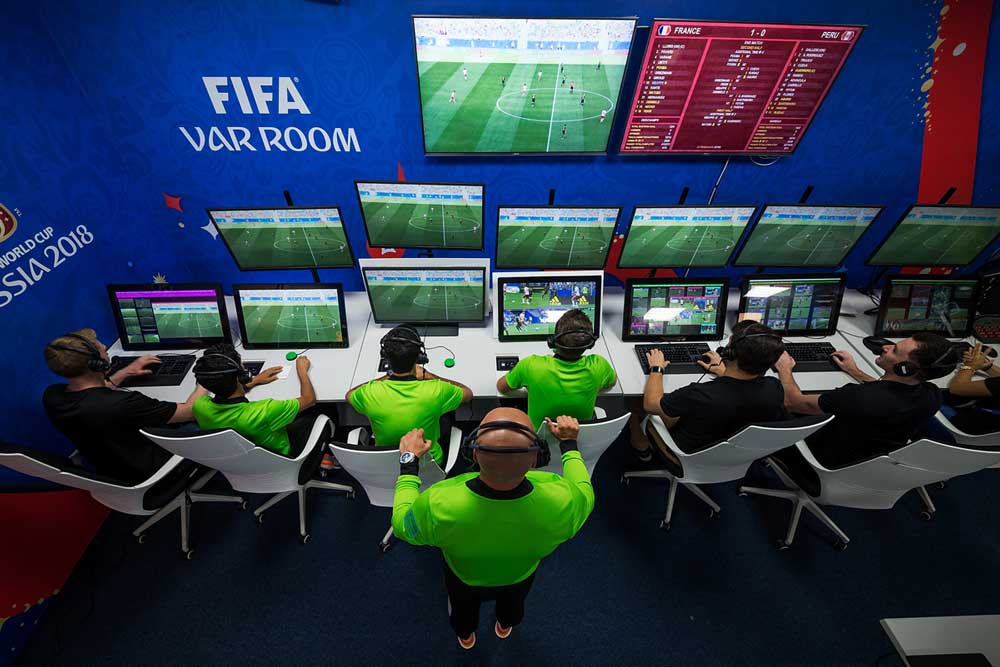Why do video assistant referees wear full uniform?
If you’ve been watching the World Cup, you may well have seen inside FIFA’s VAR (video assistance referee) control centre. Here a team of officials sit watching computer monitors so that they can double-check the on-pitch referee’s decisions in case they have missed something obvious.
You may have also noticed they are wearing full referee’s kit.

Why? You could argue that as they are set in a control centre in Moscow, sometimes 1,000 kilometres away from where the game is happening, there is little need for a dress code. Or, at least, little need for one that stipulates the traditional outfit of a referee.
But here are two reasons why it is better to wear the kit.
First, it puts them in the right frame of mind. Refereeing is a difficult job. You have to be impartial and fair. You have to make decisions that are difficult: did he use his arm to his advantage or was it a genuine accident that the ball struck him there? Is that fair wrestling for the ball or a foul? These are grey areas that often have no obvious correct answer.
In sport psychology, we talk about getting in the right mindset. When you are doing mental imagery/visualisation exercises, for example, the best thing to do is get the athlete to put their kit on and go to the field where they will play. It makes it more real.
If you want to make a VAR feel like they are on the pitch, making real game decisions, which they are, stipulating that they wear their usual refereeing kit is a great place to start.
Second, it gives them legitimacy. Systems like VAR are always going to get criticised for the mistakes they make and ignored for the many times they get things correct. It is easy for fans to look at them as bureaucrats tucked away in a tiny box, thousands of miles away from the action, and vilify them for any decisions they don’t like.
This concern is why they replay the footage that the VAR officials are watching and the superimposed lines showing how they make decisions about whether someone is offside or not.
Similarly, by putting the officials in full kit, it shows the fans that these are real referees doing a legitimate refereeing job. Thus, it makes it easier for fans to accept adverse decisions.
If you’ve been watching the World Cup, you may well have seen inside FIFA’s VAR (video assistance referee) control centre. Here a team of officials sit watching computer monitors so that they can double-check the on-pitch referee’s decisions in case they have missed something obvious.
You may have also noticed they are wearing full referee’s kit.

Why? You could argue that as they are set in a control centre in Moscow, sometimes 1,000 kilometres away from where the game is happening, there is little need for a dress code. Or, at least, little need for one that stipulates the traditional outfit of a referee.
But here are two reasons why it is better to wear the kit.
First, it puts them in the right frame of mind. Refereeing is a difficult job. You have to be impartial and fair. You have to make decisions that are difficult: did he use his arm to his advantage or was it a genuine accident that the ball struck him there? Is that fair wrestling for the ball or a foul? These are grey areas that often have no obvious correct answer.
In sport psychology, we talk about getting in the right mindset. When you are doing mental imagery/visualisation exercises, for example, the best thing to do is get the athlete to put their kit on and go to the field where they will play. It makes it more real.
If you want to make a VAR feel like they are on the pitch, making real game decisions, which they are, stipulating that they wear their usual refereeing kit is a great place to start.
Second, it gives them legitimacy. Systems like VAR are always going to get criticised for the mistakes they make and ignored for the many times they get things correct. It is easy for fans to look at them as bureaucrats tucked away in a tiny box, thousands of miles away from the action, and vilify them for any decisions they don’t like.
This concern is why they replay the footage that the VAR officials are watching and the superimposed lines showing how they make decisions about whether someone is offside or not.
Similarly, by putting the officials in full kit, it shows the fans that these are real referees doing a legitimate refereeing job. Thus, it makes it easier for fans to accept adverse decisions.